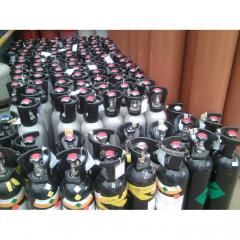PRODUCT
News center
-
2015-03-24
The safety of the mixed gas production and management -
2015-03-24
The preparation of standard gas and application -
2015-03-24
Talk about the standard gas development of our country
Current Position:Product > Rare gases
| Name: | Xe |
| Classification: | Rare gases |
| Applicable way: |
Prev:Kr
Next:No product
HOTLINE:086-757-88878300/88876111
Product Description: Xenon is a colorless, odorless, nonflammable compressed inert gas content in the air is 90ppm. Xenon flash is mainly used, the depth of anesthesia, laser welding, refractory metal cutting, standard gas, special gas mixture and so on. Krypton, xenon gas mixture filling tubes and light bulbs, 20 to 25 percent over the same argon lamp power saving, can prolong life of 2 to 3 times the luminous efficiency can be improved, and the volume can be greatly reduced. Xenon has a high shine strength, filled with xenon lights have iodine lamps, arc lamps, flash, cinema lights, lights and other space simulation. Xenon is a 1958 development of high-pressure xenon arc lamp, into the long arc xenon lamp, short-arc xenon lamp and pulsed xenon lamps, xenon-filled long arc xenon lamp, whose spectrum sunlight is very close to, the common name "Little Sun", such a xenon lamp through the fog is particularly high, commonly used in railway stations, docks and square lighting. "Short arc xenon lamp" color similar to noon sunlight, high color temperature (5600K), easy to use, is the ideal artificial "sun lamp" for squares, streets, movie and stage lighting."Pulsed xenon lamp", is a light source emitting in a very short time, often referred to as "flash", is the use of xenon gas discharge to emit light pulses, which are widely used in small xenon lamp photography. Xenon as an anesthetic, xenon is highly valued in medicine. Xenon can be dissolved in the cytoplasm of fat, causing the cells of anesthesia and expansion, so that the role of nerve endings temporarily stopped. 80% of people have tried and xenon gas mixture consisting of 20% oxygen, as no side anesthetic. In the nuclear industry, xenon can be used to verify the presence of high-speed particles, particles, such as mesons.
Note: Xenon is a colorless, odorless, non-toxic, non-combustible stored in high-pressure gas cylinders. May cause suffocation while increasing its lead content of less than 19.5 percent oxygen content. Xenon high-pressure filling gas, should be used after decompression buck before use. Life on the packaging of cylinders are used, where the expired gas cylinders must be taken to have a safety inspection department before they can continue to use. Bottle when using the exhaust gas, and pressure in the bottle should be kept 0.5MPa, more than the minimum of not less than 0.25MPa pressure cylinder valve should be closed to ensure the gas quality and safe to use. Bottled xenon gas transport and storage, the use of classification should be stacked, non-combustible gas and combustion gas stacked together, are not allowed near open flames and heat sources, do not get near the fire should be, not contaminated with oil wax, not prolonged sun exposure, not weight throw, Do not hit, were prohibited in the cylinder body arc or arc, rough handling is strictly prohibited.
Physicochemical properties of xenon
Molecular Weight: 131.30
Melting point: -111.8 ℃
Boiling point (101.325kPa): -108.1 ℃
Liquid density (108.1 ℃, 101.325kPa): 3057 kg / m3
Gas density (0 ℃, 101.325kPa): 5.887 kg / m3
The relative density (gas, 25 ℃, 101.325kPa): 4.553
Hematocrit (21.1 ℃, 101.325kPa): 0.180m3 / kg
Gas-liquid volume ratio (15 ℃, 100kPa): 550L / L
Critical temperature: 16.6 ℃
Critical pressure: 5838kPa
Critical density: 1105.2kg / m3
Compression factor:
(℃)
50
0.9959
0.9576
Heat of vaporization (-108.1 ℃, 101.325kPa): 96.30kJ / kg
Specific heat capacity (gas, 25 ℃, 101.325kPa): Cp = 160.03 J / (kg · K)
Cv = 96.41 J / (kg · K)
Specific heat ratio (gas, 25 ℃, 101.325kPa): Cp / Cv = 1.66
Vapor pressure (-20 ℃): 2634kPa
(0 ℃): 4175kPa
(10 ℃): 5147kPa
Viscosity (gas, 0 ℃, 101.325kPa): 0.02110mPa · S
(Liquid, 289.74K): 0.528mPa · S
Surface tension (-110 ℃): 18.7mN / m
Thermal conductivity (0 ℃, 101.325kPa): 0.005192W / (m · K)
(Liquid, 165.014K): 0.07322W / (m · K)
Refractive index (gas, 0 ℃, 101.325kPa, 5893?): 1.000702
(Gas, 25 ℃, 101.325kPa): 1.000642

